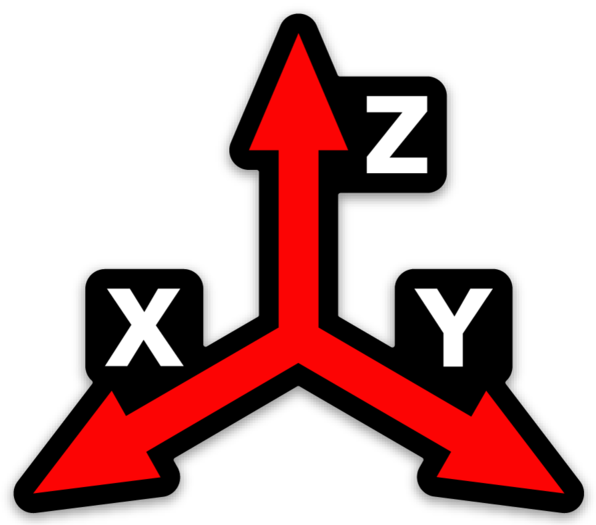Spotlight on a New Jacobs 3D Parameter: Global COMS
COMS
Center of Mass
By now, you're probably familiar with the basic concept of mass centers, or COMs (center of mass). We covered it in full detail in this July 2021 post located here.
To recap: The center of mass is the point on an object where its mass can be considered as concentrated, and the point on which the object balances.
In the book Science of the Golf Swing, we spent a lot of time investigating and discussing the center of mass of the club, along with its movement. With the addition of the full body analysis, we now locate the mass centers of different body segments and study how they interact with each other.
Padraig Harrington’s local mass centers in motion on a driver swing from 2023
As Jacobs 3D evolves into new iterations, we can see how vital it is to treat the body and club as a “global” system. This global analysis lets us break down exactly where—and how much—of the energy of motion comes from external forces (such as ground forces and gravity) and from internal forces (the joints of the body).
Global Analysis
Global Inertia Tensor
So we have the golfer and club system (global), and we have each segment (local).
BUT what about something in between?
We discussed this question and responded with a new parameter called Global COMs. We took multiple segments and located the mass center of that grouping. (For example, we took the hands, lower arms and upper arms and combined those segments and found the mass center of that group. An Arms COM was born). With a single mass center representing the arms and hands, we can see just how much that grouping moves in a swing. We then proceeded to group the body into different clusters.
The red globe in the parameter represents the COM of the arms and hands. You might hear some popular golf instruction based on the concept that the arms and hands do not lower in the downswing. Being able to see an Arm COM disproves this concept, and answers many other questions about how to build an efficient swing.
The dark blue COM is the center of mass of the axial skeleton of the body. The axial skeleton includes the head, neck, torso, abdomen and the bony “true pelvis.”
The green COM is the mass center of the upper legs, lower legs, feet and the bony “false pelvis.”
The purple COM is the mass center of the golf club and the light blue COM is the mass center of the entire system.
Nelly Korda driver swing on GEARS
Nelly Korda COMS from the same GEARS swing
Video synced with overlay
Club COM vs Total COM Relationship
The golf science industry is a peculiar place (as most dynamically changing scientific ones are). When Dr. Nesbit and I first introduced the notion of a static and dynamic moment of inertia (I-Dynamic and I-Static), the golf biomechanist community immediately speculated that a changing moment of inertia wasn’t possible. You can see some of those same folks now touting training aids and other products that boast VARIABLE INERTIA technology. It’s good that we’ve gotten to where we all can agree that manipulation of the moment of inertia is taking place in every golf swing and movement that humans have ever made—from ones as complex as hitting a driver off a bare lie in the fairway to as “simple” as standing in a way that prevents you from falling over. In basic terms, the more spread out your body segments are, the higher your moment of inertia—or resistance to twisting—becomes. Watch a figure skater spin and you can see this in action. When the skater stretches his or her arms out, the spin slows. Pull them in and he or she spins faster. Get up on a tightrope and what is your innate reaction as you try to avoiding falling? It’s reaching your arms out to stabilize yourself. This arm stretch increases your moment of inertia and makes you less likely to wobble off the tight rope.
To extend that metaphor, why do you think a professional tight rope walker carries a stick? The stick dramatically increases the entire system’s moment of inertia beyond what just the arms can achieve. In golf, we use our own “stick” in the form of a club, which means the stick has to be accounted for when we talk about the system. Our work is constantly striving to create the most accurate measurements and analysis of the entire system along with the relationship between its component parts
By tracking the system’s COM and comparing it to where the COM of the club is at any given time, we can quickly identify patterns that differentiate the level of a golfer. There are obviously lots of fine details, but for the purpose of this discussion, understand that the distance between the COM of the club (purple) and the overall COM of the system (light blue) is a main ingredient in your ability to rotate during a swing. The closer the club COM is to your overall COM, the ability to globally rotate from a given torque is enhanced. The opposite is also true. When the club is spread out at its widest from your overall COM, the response from a given torque to globally rotate is significantly reduced due to a larger moment of inertia of the system. We will continue this discussion in future essays, our next one will provide more examples and some data but in the meantime there's a whole research paper in describing what this means for golfers (and you can find that here.)






